For almost 20 years I didn't travel abroad at all, this year I made up
for it and ventured to the southern hemisphere for the first time. In October I was fortunate enough to travel to Western Australia and Indonesia, naturally the sketchbook came with me. It was well worth the long journey and the plants in Australia are stunning. I didn't sketch as much as I would have liked to but here a few pages of sketchbook studies from the trip. Can't wait to go back next year and spend more time there.
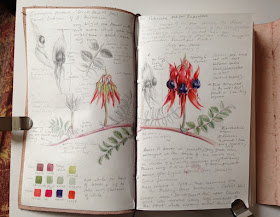 |
| Sturt's Desert Pea, Swainsona formosa, A stunning little plant and the national emblem of Southern Australia. Had to include this one even though it's such a scruffy page! Would love to go back to make a 'proper' painting of it. Being from the pea family (Fabaceae), it reminded me very much of the jade vine flowers, but has this wonderful dark shiny 'bulbous' center. |
After arriving in Bali for a few days I the made a short visit to Australia. While in Perth I visited
King's Park and Botanic Garden, which was wonderful. It was great to see so many plants in real life that I've only ever seen in other artists' work or in photographs.
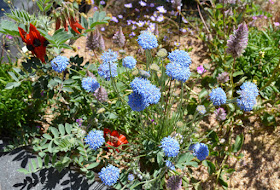 |
| Sturt's pea can be found growing amongst the colourful wildflowers at the garden, here Brunonia australis, the native cornflower grows in the dry sandy soil. |
King's Botanic garden was quite a climb in the heat but I was met the incredible view across Perth.
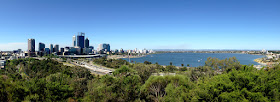 |
| The beautiful blue skies of Perth from Kings Park Botanic Garden |
The sky was the most amazing blue, with the curious looking Baob trees and Eucalyptus flowers in abundance throughout the gardens.
 |
| Baob tree Andnsonia gregorii, overlooking the coast. The enlarged trunk is an adaptation to drought and enables the storage of large amounts of water. |
Plant life in Australia is very diverse, with over 20,000 vascular plants but the flora really is very different, with unique adaptations to drought and fire shaped by continental drift and climate change since the Cretaceous period. A favourite was
Eucalyptus rhodantha, which I managed to draw.
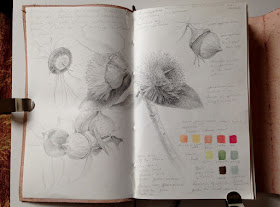 |
| Eucalyptus rhodantha, ' Rose Mallee' an endangerd plant from Westen Australia, has beautiful silver leathery leaves. Flowers are usually red but the form illustrated is a paler form. |
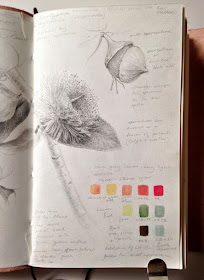 |
| When time is short - skip trying to paint the flower and make colour notes for reference instead. I love the little 'hats' which pop off this flower to reveal the multiple stamens. |
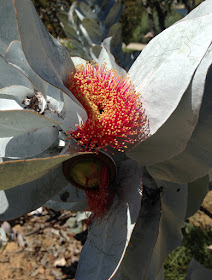 |
| The more usual red form Eucalyptus rhodantha |
I chose two sketchbooks to take with me, the usual Stillman & Birn Zeta series hardback, with its heavyweight paper and a lovely brown leather journal with hand made natural coloured paper, by Gusti Leder. This German company is better know for their vegetable dyed leather bags etc. I have to say that the paper isn't as good as the Stillman & Birn but it's fine for sketching and note making and surprisingly I found that it takes washes better than expected. However it won't take much erasing or any overworking with watercolour but was good enough for my needs. If it goes wrong, best just to move on and sketch or paint the subject again, sketchbooks aren't supposed to be perfect...mine certainly isn't! 'Sketchbooking' is one of my favourite activities and I love the evolving layout on the page as it develops. I recently started a
new course on just this subject and have a group of new students embarking on their personal sketchbook journeys. You can look at work by students on the
blog for the coursework
 |
| Gusti Leder Journal |
I packed my normal watercolour box of W & N pans and a pencil roll with just a couple of brushes, Winsor & Newton series 7 miniatures, size 1 and 4, and Faber Castell 9000 pencils, grades 2H - 6B. Although with the Gusti sketchbook, found I couldn't use anything harder than a HB.
There were so many wonderful plants to illustrate: Banksia, Kangaroo paws, Bottlebrush and many more but sadly not enough time for all and after just 3 days in Perth I moved onto a new adventure in Indonesia.
I was sorry not to have more time to meet up with other artists and of course to paint and draw more, next year I shall return and hopefully stay longer to see more of this beautiful country when I shall run some botanical art classes, visiting New Zealand too.
 |
| Goodnight Australia until next time |
Will write a post on the Indonesian sketchbooks studies at a later date....a very different experience doesn't belong in the same post










Fabulous - it seems almost tragic that your sketches are locked up in a book! A very real question - how did you travel with your watercolours? A box with pans or what? How many brushes? The book and pencil drawings seem simple...more intriguing are the small colour swatches on the pages.
ReplyDeleteThank you Liz, a very good question and something that I omitted - So have just added the information to the blog. I took pans, which I find are easier for travel but are also my preferred paints anyway. Just two brushes, both of which are W & N series 7, size 1 and 4... I that will do the job for a sketchbook, although most of the work was graphite, which I enjoy and can get lost in for hours. None of the materials took up very much room in the suitcase.
DeleteA naive followup, what colors specifically for such a trip...pallet selections would have been key. Hope you have the generosity to open up that secret as well!
DeleteClasses in Tasmania, please?
ReplyDeleteThat would be nice! Do you have any botanical arts groups in Tasmania?
DeleteBeautiful sketchbook Dianne - I love your graphite work especially. I always have.
ReplyDeleteBeautiful sketchbook Dianne - I love your graphite work especially. I always have.
ReplyDeleteThanks Jess, that's nice to hear. I love graphite too it's the most therapeutic of techniques but there just doesn't seem to be the same interest in it as with other mediums. The courses on graphite are not so popular and painting sales of graphite work aren't particulary good, so unfortunately the market determines how much graphite work I do.... We artists have to live too;) it's a shame really... Because I hear lots of botanical artists say they love graphite. I've had a huge drawing of bindweed on the easel for two years now.... Maybe I'll finish it next year :)
DeleteYour sketches are really nice! I stopped using graphite for drawings in my field sketchbooks because I find it just gets smudgy as time goes by. Don't you just love diving in to a study and taking notes all over the page though? Thanks for sharing.
ReplyDeleteThanks Mary. It does get a bit smudgy but can be fixed. I don't mind that so much though. My favourite part is filling those pages and adding notes. I just write any observation that enters my head :)
DeleteFantastic!!! Don't forget to bring it with you next week... dying to see it and I'm really really looking forward to catching up! ❤️
ReplyDeleteThanks Shevaun, will do :)
ReplyDeleteLovely sketchbook Dianne - love the Rose Mallee sketch. So many awesome Eucalypts in the West - they are very spoilt over there. We have some cool ones in the East as well. Cheers David Reynolds
ReplyDelete